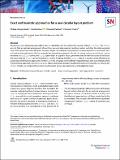| dc.contributor.author | Hungerländer, Philipp | |
| dc.contributor.author | Maier, Kerstin | |
| dc.contributor.author | Pachatz, Veronika | |
| dc.contributor.author | Truden, Christian | |
| dc.date.accessioned | 2021-09-20T17:41:43Z | |
| dc.date.available | 2021-09-20T17:41:43Z | |
| dc.date.issued | 2020-05-08 | |
| dc.identifier.uri | https://hdl.handle.net/1721.1/132058 | |
| dc.description.abstract | Abstract
We discuss a new facility layout problem, the so-called Directed Circular Facility Layout Problem (DCFLP). The DCFLP aims to find an optimal arrangement of machines on a circular material handling system such that the total weighted sum of the center-to-center distances between all pairs of machines measured in clockwise direction is minimized. Several real-world applications, like for example the optimal arrangement of a set of cutting tools on a tool turret, can be modeled as a DCFLP. Further, the DCFLP generalizes a couple of layout problems that are well-discussed in literature. We show that the DCFLP can be modeled as a Linear Ordering Problem (LOP). Hence, it can be solved efficiently by using exact and heuristic approaches for the LOP. First, we apply a Semidefinite Programming as well as an Integer Linear Programming approach. Moreover, we use a Tabu Search and a Variable Neighborhood Search heuristic, for solving the DCFLP. Finally, we compare the practical performance of our approaches in a computational study. | en_US |
| dc.publisher | Springer International Publishing | en_US |
| dc.relation.isversionof | https://doi.org/10.1007/s42452-020-2734-z | en_US |
| dc.rights | Creative Commons Attribution | en_US |
| dc.rights.uri | https://creativecommons.org/licenses/by/4.0/ | en_US |
| dc.source | Springer International Publishing | en_US |
| dc.title | Exact and heuristic approaches for a new circular layout problem | en_US |
| dc.type | Article | en_US |
| dc.identifier.citation | SN Applied Sciences. 2020 May 08;2(6):1035 | en_US |
| dc.contributor.department | Massachusetts Institute of Technology. Laboratory for Information and Decision Systems | |
| dc.identifier.mitlicense | PUBLISHER_CC | |
| dc.eprint.version | Final published version | en_US |
| dc.type.uri | http://purl.org/eprint/type/JournalArticle | en_US |
| eprint.status | http://purl.org/eprint/status/PeerReviewed | en_US |
| dc.date.updated | 2021-03-14T05:10:32Z | |
| dc.language.rfc3066 | en | |
| dc.rights.holder | The Author(s) | |
| dspace.embargo.terms | N | |
| dspace.date.submission | 2021-03-14T05:10:32Z | |
| mit.license | PUBLISHER_CC | |
| mit.metadata.status | Authority Work and Publication Information Needed | |
